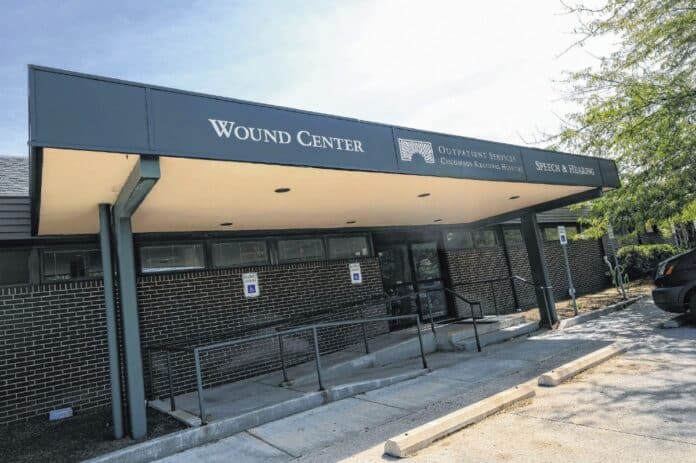
This past December, as the holiday season was in full swing, Jim Self, a 65-year-old Columbus resident, found himself hobbled with a mysterious, but crippling pain in his right foot that kept getting worse.
“I noticed a black spot on my foot about the size of a quarter, and it just kept getting more tender,” Self said. “…Just standing up, it was just like, ‘God, take this pain away.’ It would just shoot up my leg to my hip. My foot felt like a block of ice, but at the same time, when I tried to walk, it would burn like fire.”
Self went to his family doctor, who promptly sent him to Columbus Regional Hospital, where he received some unsettling news.
He had a diabetic foot ulcer on his right foot — and if action wasn’t taken soon, his foot could be amputated.
[sc:text-divider text-divider-title=”Story continues below gallery” ]Click here to purchase photos from this gallery
“I started thinking, ‘Am I going to live the rest of my life in a wheelchair? Am I going to be able to walk? Am I going to be able to drive?’ Self said. “…It’s a game-changer, no doubt. I just made up my mind when I was in the hospital. When you’ve got tubes, hoses hooked to you, and your leg’s laying there and everybody’s coming in saying, ‘You’re going to get that taken off,’ you think different. It changes your whole thought process. I just made up my mind in the hospital that I was going to beat it, it wasn’t going to beat me. It’s as simple as that.”
Self is one of thousands of patients who have been treated at the Columbus Regional Health Wound Center, 3015 10th St., in recent years amid a rapidly expanding diabetes epidemic in Indiana and the United States that has resulted in more patients needing limb-saving medical care.
In 2011, the CRH Wound Center treated 466 patients, according to figures provided by CRH. In 2018, that number had jumped to 672. As of Wednesday, 552 patients had been treated at the wound center so far this year. CRH officials project that an estimated 732 patients will be seen before the end of the year.
Not all of the patients seen at the wound center are diabetic, but about half up to 60% of current patients at the wound center are diabetic, said Kelsey DeClue, CRH spokeswoman.
The sharp uptick in patients seeking limb-saving wound treatment in Bartholomew County is due, in large part, to “the increase in patients with diabetes, the increase in patients with peripheral arterial disease and unfortunately, the American lifestyle, diet,” said Dr. John Hladik, a Columbus Regional Health podiatrist.
The influx of patients prompted officials at the wound center to launch the CRH Limb Preservation Program last month, said Hladik, who is the program’s medical director.
The program seeks to prevent lower-limb amputations in patients with vascular disease and diabetes by coordinating, collaborating and expediting treatment among different physicians and specialists, which Hladik said at times had been an obstacle in the past.
“Our community has a high number of diabetics, and a large number of people with peripheral arterial disease, and this seems to be a trend worldwide as well,” Hladik said. “As that patient population increased, those patients came to us more frequently, and that’s where we began to see the need.”
“We’ve seen over the years that the quicker these folks get treated, the more limbs we save,” Hladik said.
‘Life or limb’
Rates of diabetes have exploded across the United States in recent years, more than doubling since the 1990s, according to the federal Centers for Disease Control and Prevention.
In 2015, 30.3 million people in the United States had diabetes, or nearly 10% of the U.S. population, according to the CDC. An additional 84.1 million adults ages 18 years old or older had pre-diabetes, meaning that their blood glucose levels were elevated, but not yet high enough to be type 2 diabetes.
Diabetes is a chronic disease that occurs when the amount of blood glucose, also known as blood sugar, in the body is too high. Having too much glucose in the blood over the long term can increase the risk of developing cardiovascular disease, kidney failure, nerve damage and a host of other medical conditions.
Type 1 diabetes is believed to be caused by an autoimmune response that results in the body halting the production of insulin, a hormone produced by the pancreas that helps the body’s cells process glucose into energy, according to the National Institute of Diabetes and Digestive and Kidney Diseases.
Type 2 diabetes, the most common type of diabetes in the United States, occurs when the body does not use insulin properly, which prevents the body from maintaining normal levels of blood glucose.
Around 85% of people with type 2 diabetes are overweight or obese, according to the American Diabetes Association. The World Health Organization defines obesity as having a body mass index of 30 or above, and overweight as having a body mass index between 25 and 29.9.
In Bartholomew County, 10.6% of adults ages 18 years or older had diabetes in 2016, according to the CDC.
Poorly controlled blood sugar can limit blood flow to the lower legs and toes, which causes nerve damage that can lead to wounds or sores that do not heal on the toes, feet or legs.
If left untreated, the sores or wounds can develop infections, which may require amputation. Diabetes is the leading cause of lower-limb amputations in the United States, according to the CDC. The American Journal of Accountable Care estimates that someone in the United States is diagnosed with diabetes every 17 seconds, and 230 people will undergo a diabetes-related, lower-limb amputation every day around the country.
“It is absolutely time-sensitive,” Hladik said. “These folks are losing tissue on their foot or leg. …You do get past the point of no return. There are some people who come into the hospital or here who have waited too long. If there’s too much dead tissue, then sometimes those folks are faced with an amputation or death. They’re down to that. We are faced with those people who waited too long, and loved ones have told them, ‘You need to get that checked, you need to get that checked.’ And it advances so quickly, and they’ll come into the emergency room with a very dark, black leg, sick with a fever. At that point, it’s truly life or limb.”
Saving his foot
In January, Self underwent a bypass operation on his right leg to restore blood flow to the foot, Hladik said. Then, the dead tissue was surgically removed and cleaned out. After being discharged from Columbus Regional Hospital, he was referred to the CRH Wound Center, where he was seen from mid-February to early May.
“I had a 2-inch by 2-inch piece (of tissue) about an inch deep down to the bone taken out, and it has all grown back,” said Self, who took off his shoes and lifted up his right foot to show where the procedure was done. “Right here, it was all cut out and that was all removed. It was black with dead skin, and they removed it.”
One of the main treatments Self received at the wound center was hyperbaric oxygen chamber therapy.
A hyerbaric oxygen chamber is around 7.5-foot long and looks like a bed enclosed in a transparent, circular tube. The chamber exposes the body to pure oxygen at up to 2.5 times normal air pressure, which can speed up the healing process of a wound.
Self spent two hours per day for 30 days in the chamber.
“I’ve seen amputees before, especially since coming (to the wound center),” Self said. “It’s a once-in-a-lifetime chance, because once you take your leg or foot off, it’s gone. This could save a lot of people. It’s well worth the time. (My foot) is almost completely healed. They cut a big chunk of it out. I was in a wheelchair for a month, a walker for two weeks, a cane for two weeks. Now I can get out and mow the yard.”
Besides the hyperbaric chambers, the wound center offers an assortment of treatments, including multiple-layer compression bandages and EpiFix, a treatment made from donated placentas and stem cells that can expedite the healing process.
“The mother will decide before delivery that she wants to donate her placenta,” said Franklin Hawes, CRH Wound Center program director. “Then an organization that specializes in that will be in the hospital. The baby’s born, then they remove the placenta, it’s packaged there in the room and they take it off for processing.”
However, one of the biggest challenges of treating diabetes-related wounds is getting people to watch what they eat and control their blood sugar levels, Hladik said.
“We can do all this advanced stuff, but if our patient doesn’t listen or doesn’t behave and won’t control their blood sugar or their blood pressure, then it’s very difficult for us to make progress,” Hladik said.
Self, who confessed to being a junk food enthusiast in the past, said that living a healthy lifestyle is key.
“Put your faith in God, and it pays to take care of yourself,” Self said. “Don’t wait 65 years like I did and then start taking care of yourself. You’ve got to start young.”
[sc:pullout-title pullout-title=”About the CRH Wound Center” ][sc:pullout-text-begin]
Visit crh.org/service-centers/wound-center for more information about the Columbus Regional Health Wound Center.
[sc:pullout-text-end]




